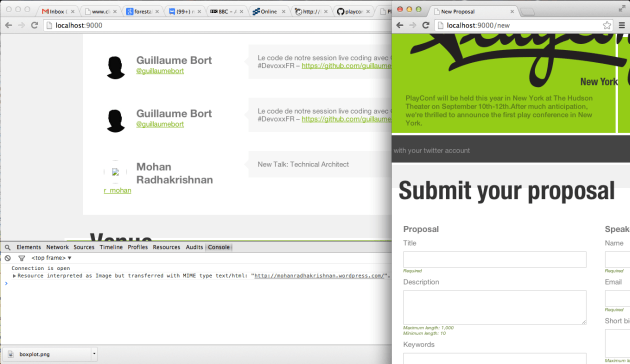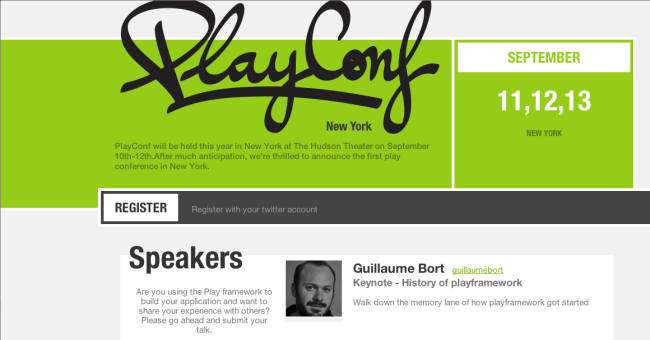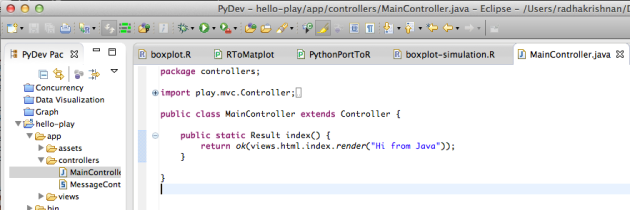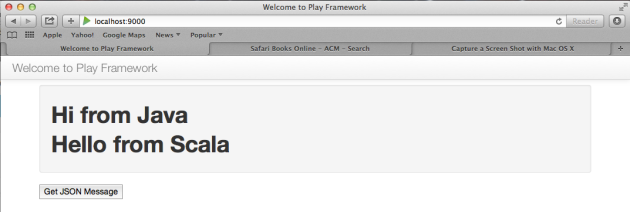I followed the instructions to deploy the Play application to CloudBees.
CloudBees SDK
I installed this SDK to interact with the cloud infrastructure. So this created a profile based
on my CloudBees account.
Mohans-MacBook-Pro:cloudbees-sdk-1.5.2 radhakrishnan$ bees help
# CloudBees SDK version: 1.5.2
# CloudBees Driver version: 1.3.8
Installing plugin: org.cloudbees.sdk.plugins:ant-plugin:1.3.0
You have not created a CloudBees configuration profile, let’s create one now…
Enter your default CloudBees API end point [us | eu]: us
Enter your CloudBees account email address: radhakrishnan.mohan@gmail.com
Enter your CloudBees account password:
Plugin installed: org.cloudbees.sdk.plugins:ant-plugin:1.3.0
Installing plugin: org.cloudbees.sdk.plugins:app-plugin:1.5.6
Plugin installed: org.cloudbees.sdk.plugins:app-plugin:1.5.6
Installing plugin: org.cloudbees.sdk.plugins:config-plugin:1.3.2
Plugin installed: org.cloudbees.sdk.plugins:config-plugin:1.3.2
Installing plugin: org.cloudbees.sdk.plugins:db-plugin:1.3.3
Plugin installed: org.cloudbees.sdk.plugins:db-plugin:1.3.3
Installing plugin: com.cloudbees.sdk.plugins:service-plugin:1.2.3
Plugin installed: com.cloudbees.sdk.plugins:service-plugin:1.2.3
Type ‘bees help ‘ for help on a specific subcommand.
SDK subcommands:
help List all commands
init Re-initialize the SDK config file
plugin:delete Delete a SDK plugin
plugin:info Get SDK plugin information
Application deployed to CloudBees
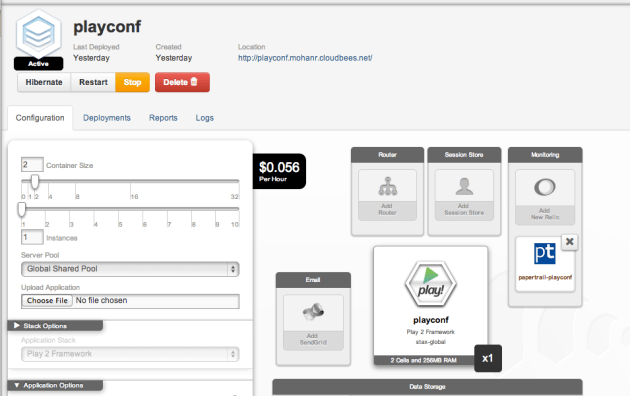
Provisioned MySQL on CloudBees

The parameters I was supposed to set
Mohans-MacBook-Pro:cloudbees-sdk-1.5.2 radhakrishnan$ bees config:set -a mohanr/playconf AppDynamics=false
Application config parameters for mohanr/playconf: saved
Application Parameters:
applyEvolutions.default=true
DB_USER=mohanr
DB_PASS=test
DB_URL=jdbc:mysql://ec2-50-19-213-178.compute-1.amazonaws.com:3306/playconftest
applyDownEvolutions.default=true
AppDynamics=false
Runtime Parameters:
java_version=1.7
The settings to enable evolutions did not work and I could not access the application.
So I switched off the evolution facility and removed 1.sql and then deployed the application. I think this evolution facility can be switched off in application.conf also.
Application Parameters:
DB_USER=mohanr
DB_PASS=test
applyDownEvolutions.default=false
applyEvolutions.default=false
DB_URL=jdbc:mysql://ec2-23-21-211-172.compute-1.amazonaws.com:3306/helloplaytest
AppDynamics=false
Runtime Parameters:
java_version=1.7
Deployment
Mohans-MacBook-Pro:hello-play radhakrishnan$ ./activator dist
Java HotSpot(TM) 64-Bit Server VM warning: ignoring option MaxPermSize=256m; support was removed in 8.0
[info] Loading project definition from /Users/radhakrishnan/Documents/hello-play/project
[warn] Multiple resolvers having different access mechanism configured with same name ‘typesafe-ivy-releases’. To avoid conflict, Remove duplicate project resolvers (`resolvers`) or rename publishing resolver (`publishTo`).
[info] Set current project to hello-play (in build file:/Users/radhakrishnan/Documents/hello-play/)
[info] Packaging /Users/radhakrishnan/Documents/hello-play/target/scala-2.10/hello-play_2.10-1.0-SNAPSHOT-sources.jar …
[info] Done packaging.
[info] Main Scala API documentation to /Users/radhakrishnan/Documents/hello-play/target/scala-2.10/api…
[info] Wrote /Users/radhakrishnan/Documents/hello-play/target/scala-2.10/hello-play_2.10-1.0-SNAPSHOT.pom
[info] Packaging /Users/radhakrishnan/Documents/hello-play/target/scala-2.10/hello-play_2.10-1.0-SNAPSHOT.jar …
[info] Done packaging.
model contains 30 documentable templates
[info] Main Scala API documentation successful.
[info] Packaging /Users/radhakrishnan/Documents/hello-play/target/scala-2.10/hello-play_2.10-1.0-SNAPSHOT-javadoc.jar …
[info] Done packaging.
[info]
[info] Your package is ready in /Users/radhakrishnan/Documents/hello-play/target/universal/hello-play-1.0-SNAPSHOT.zip
[info]
[success] Total time: 16 s, completed Feb 23, 2014 9:23:11 PM
Mohans-MacBook-Pro:hello-play radhakrishnan$ bees app:deploy -a playconf -t play2 target/universal/hello-play-1.0-SNAPSHOT.zip
-bash: bees: command not found
Mohans-MacBook-Pro:hello-play radhakrishnan$ source ~/.profile
Mohans-MacBook-Pro:hello-play radhakrishnan$ bees app:deploy -a playconf -t play2 target/universal/hello-play-1.0-SNAPSHOT.zip
Deploying application mohanr/playconf (environment: ): target/universal/hello-play-1.0-SNAPSHOT.zip
Application parameters: {containerType=play2}
……………………uploaded 25%
……………………uploaded 50%
……………………uploaded 75%
……………………upload completed
deploying application to server(s)…
Application mohanr/playconf deployed: http://playconf.mohanr.cloudbees.net
Create tables using MySQL Workbench

The application was accessible now as the following screenshots show.



